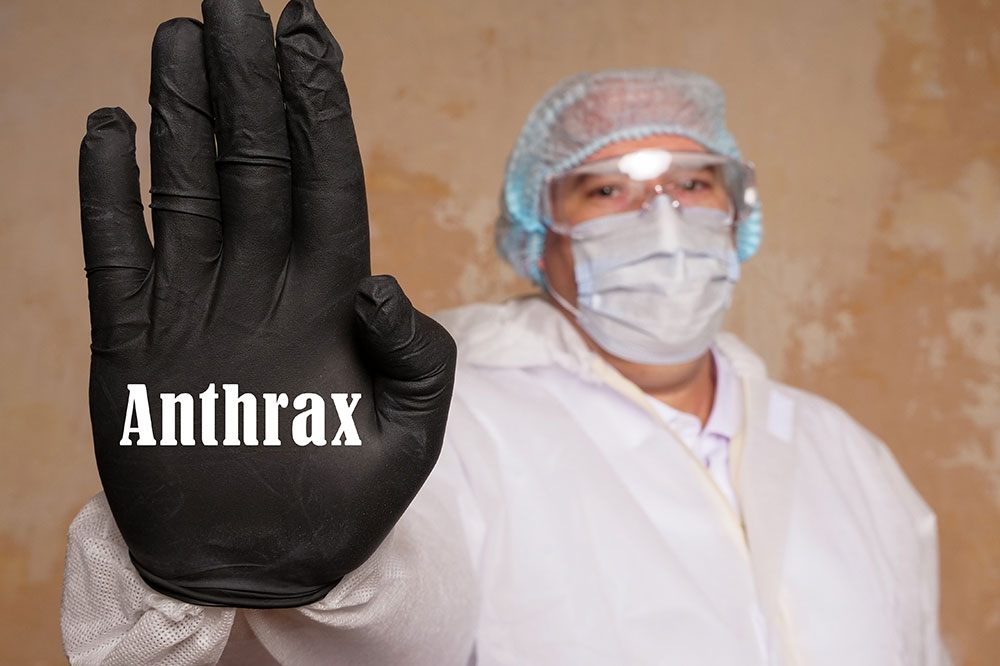
Anthrax – Symptoms, causes, and management
Anthrax primarily affects livestock and wild animals; however, humans can contract this infection from sick animals through direct or indirect contact. Bacillus anthracis, a spore-forming bacteria, causes this rare infection. Although there is no evidence that anthrax spreads from person to person, skin lesions caused by the disease could be contagious through direct contact or contact with a contaminated substance. The bacteria often enter the body through a skin wound.
Common types and symptoms
Symptoms of anthrax can vary depending on the source of infection. However, one may experience skin sores, vomiting, or shock. Here are the symptoms associated with different types of anthrax:
Cutaneous anthrax: This is a skin-related type of infection that enters through a cut or sore, which is the most common route for the bacteria to enter the body. Here, one may notice a red, itchy bump that turns into a sore with a black center. It can be accompanied by flu-like symptoms like headache or fever and swelling in the nearby lymph glands. Cutaneous anthrax can be treated and is usually a mild form of infection.
Gastrointestinal anthrax: This refers to anthrax in the gastrointestinal tract that is brought on by contaminated food. However, one may experience fever, nausea, vomiting, stomach discomfort, and bloody diarrhea. Here, a variation of this type is oropharyngeal anthrax which affects the tonsils, posterior pharyngeal wall, or hard palate. In addition, the soft tissue in the neck can become swollen, and the lymph nodes expand. The symptoms include hoarseness, a sore throat, fever, and dysphagia. In addition, there could be an obstruction in the airway.
Inhalation anthrax: This type develops as a flu-like illness when one inhales anthrax spores. Here, the fever worsens with time, potentially causing chest pain, severe breathing problems, cyanosis, shock, and coma. One might also have to deal with nausea, swallowing issues, and muscle aches. The infection can cause serious health issues and requires immediate treatment.
Most symptoms of anthrax develop after 1 to 6 days of exposure, but those of inhalation anthrax can take up to 6 weeks to develop.
Causes
Anthrax is commonly observed in domestic animals, such as sheep, cattle, and goats. Humans who come into contact with such hosts through their meat or skin can get infected with anthrax. The bacteria can enter the body via the mouth, the skin (cutaneous), or the lungs (inhalation).
Cutaneous: Skin cuts and scrapes allow anthrax spores to enter the body, resulting in cutaneous anthrax. This is the most common anthrax infection. The most significant risk factor here is contact with infected animals or their bones, hair, or skin. Agricultural workers, veterinary professionals, tanners, and wool workers are the most vulnerable to cutaneous anthrax.
Gastrointestinal anthrax: Here, the bacteria enter the digestive tract through contaminated and undercooked meat.
Inhalation: This is when anthrax spores enter the lungs through the airways. Most infections are triggered by one inhaling anthrax spores in the air while performing chores such as tanning skins and processing wool. Upon breathing in the spores, one may not experience symptoms immediately. The bacterial spores must germinate or sprout before symptoms appear. This procedure usually takes 1 to 6 days. Once the spores germinate, they release a multitude of toxic compounds.
Diagnosis
If one suspects they could have been exposed to the bacteria or an infected animal, they should consult a doctor right away and get checked for anthrax. This is because symptoms can take a while to develop, so one might not realize they are infected. The doctor will recommend a blood test to determine whether the body has any anthrax antibodies or toxins produced by the bacteria. One may also have to give skin swabs, spinal fluid, feces, or mucus as samples. The doctor can examine the symptoms, if any, and one can discuss the route of infection they suspect. The doctor will then call for a chest X-ray or CT scan to check for inhalation anthrax if that is the suspected routine.
Treatment
Prescription options are usually recommended to treat anthrax infection. Some can fight the bacteria, while others focus on eliminating the toxins caused by the infection. Surgical removal of affected tissue can also be recommended for some patients.
Those who work with livestock are more likely to contract this infection. So, one can discuss preventive measures with healthcare experts if they believe they are at a higher risk of contracting anthrax. Further, one can avoid eating undercooked or raw meat and petting or touching animals in areas known to have a high incidence of anthrax.




